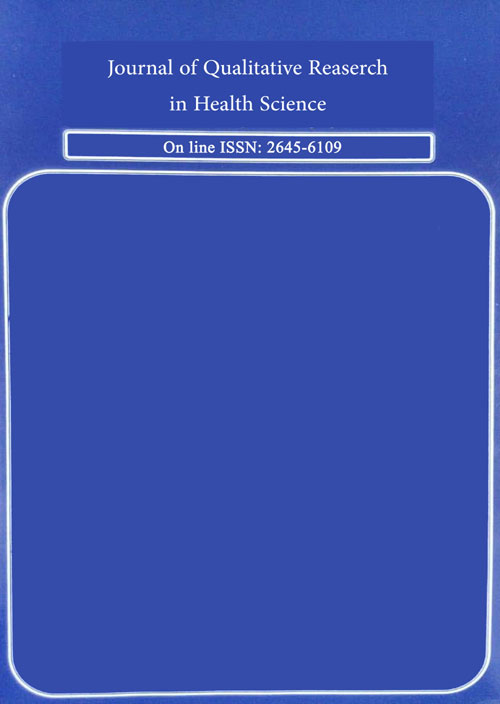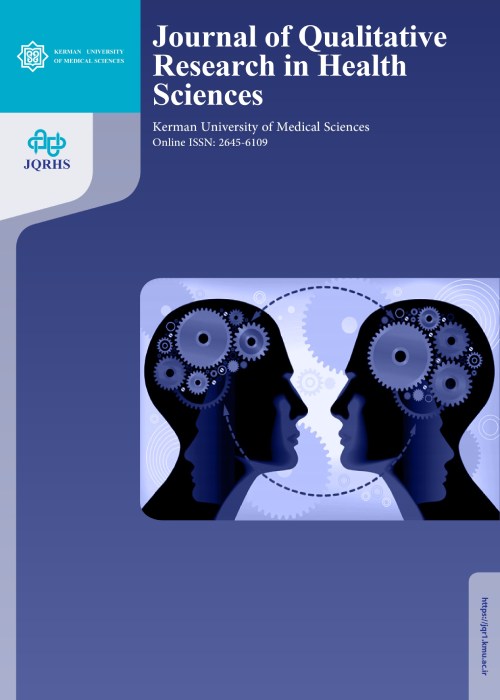فهرست مطالب

Journal of Qualitative Research in Health Sciences
Volume:10 Issue: 1, Spring 2021
- تاریخ انتشار: 1400/03/30
- تعداد عناوین: 8
-
-
Pages 1-10Introduction
Child-abuse is one of the most common socio-psychological problems, and can contribute to the development of a set of intrapersonal, interpersonal, and peripheral harms in child and adolescent victims. This study aims at identifying the harmful consequences and harms of childabuse (child maltreatment) in child and adolescent victims from the perspective of specialists (counselors, psychologists, and social workers).
MethodsThis study was carried out using a qualitative and interpretive phenomenological approach. The research population included all specialists in the field of psychological and social health (counselors, psychologists, and social workers) in Isfahan and Tabriz Universities in 2018, who were experienced in research and treatment in child abuse. The participants were 9 specialists who were selected using purposive sampling. The data were collected through interviews with the participants. All the interviews were recorded and then transcribed line by line. The data extracted from the interviews were analyzed using the interpretive analysis approach proposed by Diekelmann, Allen, and Tanner.
ResultsThe analysis of the data extracted from the interviews revealed five main themes (psychological, behavioral, interpersonal, family, and social harms) and 31 subthemes related to child-abuse harms and consequences from the perspective of the specialists.
ConclusionThe insights from this study can be used to develop educational, preventive, and therapeutic programs aimed at reducing child abuse and its harmful effects.
Keywords: Specialists, Child-Abuse harms, Interpretative phenomenology -
Pages 11-22Introduction
Being in a situation to use white lie is a challenging experience for healthcare providers. Recognizing the situations that facilitate white lies and providing solutions to them are effective in providing patients with the truth about their treatment and reducing white lies. The objective of this study was to explore the experiences of patients’ families, nurses, and physicians in using white lies during care process.
MethodsThis study, with a triangulation approach, was conducted in 2018 at the hospitals affiliated to Tehran University of Medical Sciences. Data were collected in two qualitative and quantitative phases from three sources including patients’ families, nurses, and physicians. In the quantitative phase, 300 samples were selected by random sampling to complete a researcher-made questionnaire. Descriptive statistics and frequency tables were used to analyze the quantitative data. In the qualitative phase, 30 individuals from above-mentioned sources were selected by purposive sampling to participate in the face-to-face and semi-structured interviews. Data analysis in qualitative phase was done by Graneheim and Lundman’s conventional content analysis. In the final step, quantitative and qualitative data were compared and interpreted.
ResultsThe findings of qualitative phase were summarized in four categories (inappropriate situation, patient expediency, surrounding frameworks, and communication bridges) and eight subcategories. In the quantitative phase, the highest score was related to the category of patient expediency. It was also found that the findings of qualitative and quantitative phases were consistent and complementary to each other.
ConclusionAccording to the findings, the use of white lies was for patient’s benefit and to create an appropriate situation for telling the truth. In this regard, providing appropriate guidelines in accordance with the culture, therapeutic goal, and understanding of patients can enhance caregivers’ skills in rendering information to patient. The findings of this study can be used as a guide in other qualitative and quantitative researches regarding the use of white lie in patient care and its consequences.
Keywords: White lie, Truth-Telling, Care, Triangulation -
Pages 23-28Introduction
The presence of a child with a specific learning disability in the family who needs care and has special educational problems is a source of stress for mothers, affecting their mental health and adjustment. This study aimed to explore the lived experiences of mothers of children with specific learning disability (SLD).
MethodsThis qualitative study was conducted using a phenomenological approach. The participants were 14 mothers of children with specific learning disability (SLD) whose data were collected through semi-structured interviews. The participants were selected using purposive sampling and the collected data were analyzed via Colaizzi's method of data analysis.
ResultsAnalysis of the data revealed 4 main themes including “impact on family”, “the mother’s life”, “the student’s problems”, “concerns”, and “needs”, and 14 subthemes.
ConclusionThe present study showed that specific learning disability has diverse effects on the child, mother, and family, and recognizing these effects can pave the way for taking supportive and therapeutic measures.
Keywords: Specific Learning Disability (SLD), Lived Experiences, Phenomenology, Mothers -
Pages 29-36Introduction
Collaborative learning encourages students to work with peers and leads to the development of problem-solving and communication skills, and the transfer of knowledge learned in the classroom to be used in the clinical setting. This study aims to explain the role of collaborative learning experiences of nursing students in the field of clinical training.
MethodsIn this qualitative study, 20 nursing students who experienced specialist clinical training were selected using object-based sampling. The data were collected using semi-structured and focus group interviews. The interviews were transcribed verbatim and the relevant themes were extracted and categorized using content analysis.
ResultsThe results revealed that group interactions lead to useful experiences in clinical works. It was also shown that collaborative learning affects the clinical success of nursing students. The participants stated that group work in clinical settings is the most important learning experience in the training course. While contributing to learning development, group participation helps the students to deal with the assigned tasks more efficiently and support each other by sharing their knowledge and establishing friendly relations. The themes derived from the data included 1) peer support, 2) clinical reasoning, and 3) group capabilities.
ConclusionCollaborative learning is an important factor in improving clinical work. The results of the present study underlined the weakness of educational programs in terms of collaborative learning. Therefore, educators and education professionals are recommended to support the development of a suitable context for active and collaborative education and learning.
Keywords: Education, Nursing students, Clinical setting, Collaborative learning -
Pages 37-42Introduction
Currently, education means providing facilities that enable learners to acquire theoretical information and knowledge and help them put this knowledge into practice. Periodic reviews also serve as a first step required to gain a deeper understanding of problems and access to information and newer solutions. Therefore, to identify the challenges of clinical education, the present study focused on exploring undergraduate public health students’ experiences of internship courses.
MethodsThis study used the conventional content analysis method. The participants were 11 undergraduate public health students of Qom University of Medical Sciences selected via purposive sampling in 2017. The data were collected through in-depth semi-structured interviews as well as focus group and the data collection process continued until the data were saturated. The content analysis was performed following Graneheim and Lundman’s model.
ResultsThe analysis of the data revealed five main themes. The main themes identified in this study were weak curriculum planning, poor communication between the faculty and health centers, the students’ unpreparedness to start the internship course, the staff’s lack of cooperation, and students’ expectations.
ConclusionThe present study indicated that most students faced many problems during their field internships and they demanded the improvement of the teaching processes of theoretical courses and practical skills. Therefore, officials of the educational system are required to plan more coherent programs, offer both theoretical and practical courses more effectively, and prepare students to start internship courses and establish effective communication.
Keywords: Experience, Student, Health, qualitative research -
Pages 43-47Introduction
Due to the harmful nature of self-harm, studying in this field is especially important in adolescents. The objective of this study was to identify the causes of self-harm in adolescent girls in the socio-cultural context of Kermanshah.
MethodsThis qualitative and phenomenological study was conducted in 2017 and the participants in the study were 21 adolescent girls with a history of self-harm that were selected using snowball sampling method-. Collaizi’s seven-step method was used for qualitative analysis of texts.
ResultsThe semantic units of the interviews were categorized into 135 conceptual codes. The themes related to the causes of self-harm were classified into three categories: a. Family- related factors including poor verbal communication among family members, neglect and lack of love, discrimination between the sexes, parental control, type of family upbringing, threats from the mother, fear of the father, being indifferent, and etc., b. Environmental factors and conditions including taking friends as role models, being fashionable, being provoked by sad songs, being influenced by violent movies death of the relatives, taking role models from cyber space, etc., and c. Individual Factors including finding grandeur, proof of courage, loneliness, nervousness, interest in experiencing, impulsiveness, relationship with the opposite sex, emotional failure, and drawing attention.
ConclusionThe results of this study revealed that adolescents see self-harm as a way to get rid of negative emotions or get back their neglected rights. Having disputes with parents, being overwhelmingly influenced by friends and peers, and having severe mental conditions all play a significant role in causing self-harm.
Keywords: Causes of Self-Harm, Adolescent girls, Socio-Cultural Context, Kermanshah -
Pages 48-55Introduction
Heart transplantation is a standard treatment for end-stage cardiac disease. In addition to inducing physical changes and improving the quality of life, it causes unique mental and psychological changes in transplant recipients. Therefore, this study sought to explain and interpret the experience of heart transplant recipients in Iran.
MethodsUsing a qualitative content analysis approach, this study was performed on 13 heart transplant recipients in Tehran. The data were collected through observation and semi-structured interviews. The participants were selected using purposive sampling, and the interviews continued until data saturation. After obtaining informed consent, interviews were recorded, transcribed, and analyzed using conventional and concurrent content analysis.
ResultsThe analysis of the data revealed two stages experienced by heart transplant recipients. The transition stage was categorized into two concepts of "emotional turmoil" and "feeling of duality". The emotional turmoil was subcategorized into feeling guilty, alienation with the new heart, and gratitude. Besides, the "feeling of duality" was subdivided into personality change and lifestyle changes. The stabilization stage was conceptualized into “self-acceptance” which was subcategorized into three concepts of the acceptance of the new heart, feeling of unity with the donor, and normalization.
ConclusionAdaptation to the new heart is a multistage process in heart transplant recipients. Based on the insights from this study, it can be concluded that healthcare professionals need to improve their knowledge of post-transplant changes, recipients’ feelings, and their adaptation strategies. They are also advised to address the physical needs and mental concerns of transplant recipients.
Keywords: Adaptation, New Heart, Heart transplant -
Pages 56-64Introduction
Mental health is the prevention of minor behavioral disorders and problems and health promotion is the best form of mental health. The present study aimed to explore the mental health and mental well-being of high school teachers and its effectiveness in emotional and disciplinary relationships of high school students in Ilam, as these relationships are of great importance.
MethodsThis qualitative and phenomenological study was conducted on all male and female high school teachers in Ilam in the academic year 2018-2019. The participants in the research sample were 24 teachers from different high schools in the city who were selected using purposive sampling. The data were collected through observation, semi-structured interviews, and open-ended written questions, and were analyzed through a coding procedure to extract main themes and subthemes related to the phenomenon under study based on previous studies in the literature.
ResultsFindings included 5 main themes of teachers 'mental health, positive change in students' behavior, attention to emotional and psychological dimension in disciplinary approaches, interaction between teachers and students and motivation was progress.
ConclusionGiven the effect of teachers’ mental health on improving the quality of students' behaviors, psychologists and counselors can use sound mental health and educational models to improve learners' interaction and teach them how to relate to the family, thereby increasing student satisfaction and family cohesion.
Keywords: Teachers, mental health, Emotional Relationships, Disciplinary Relationships, Students


